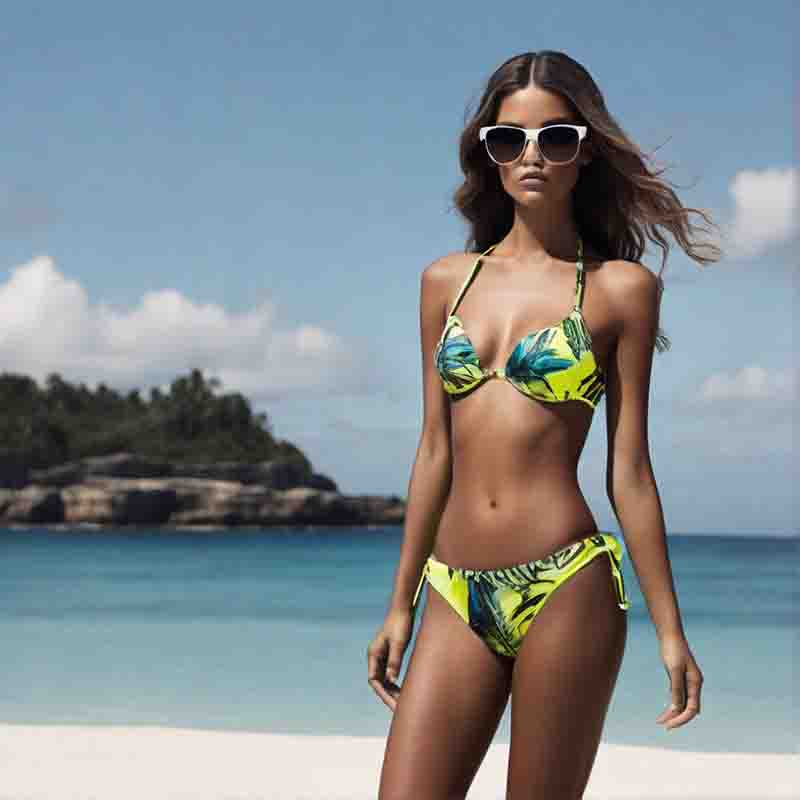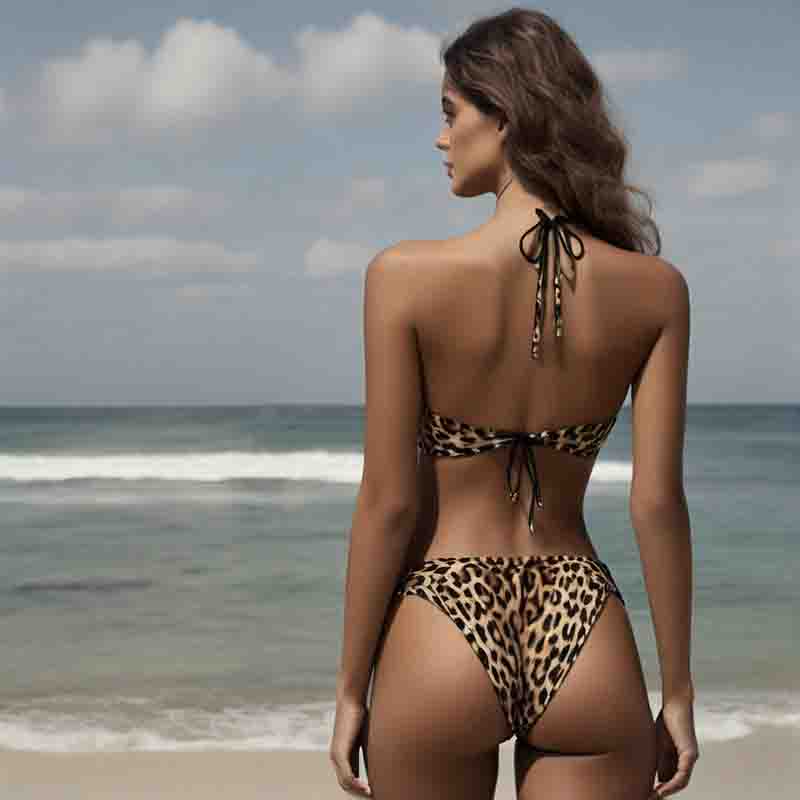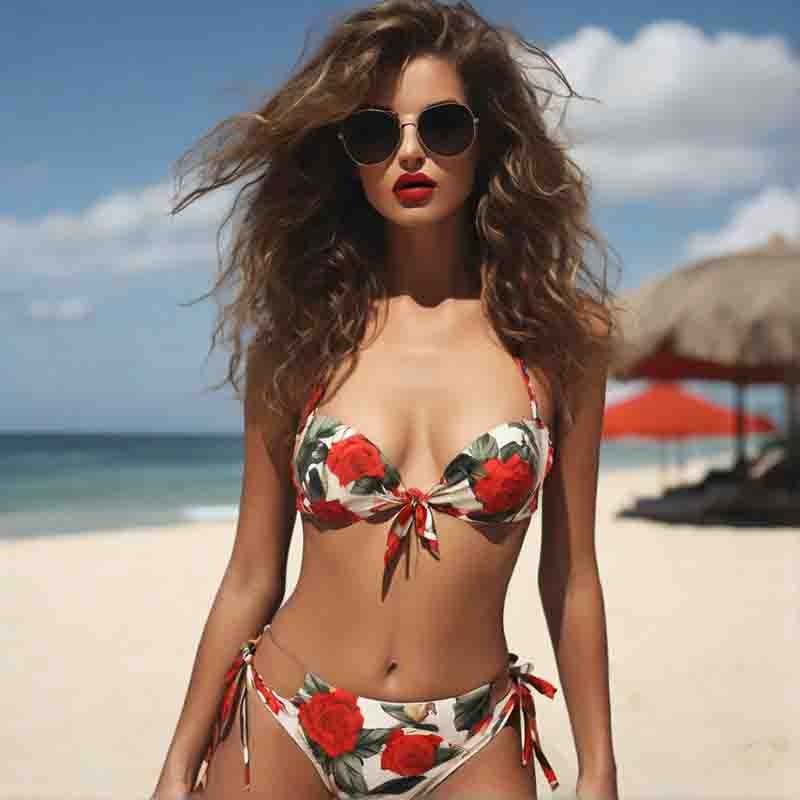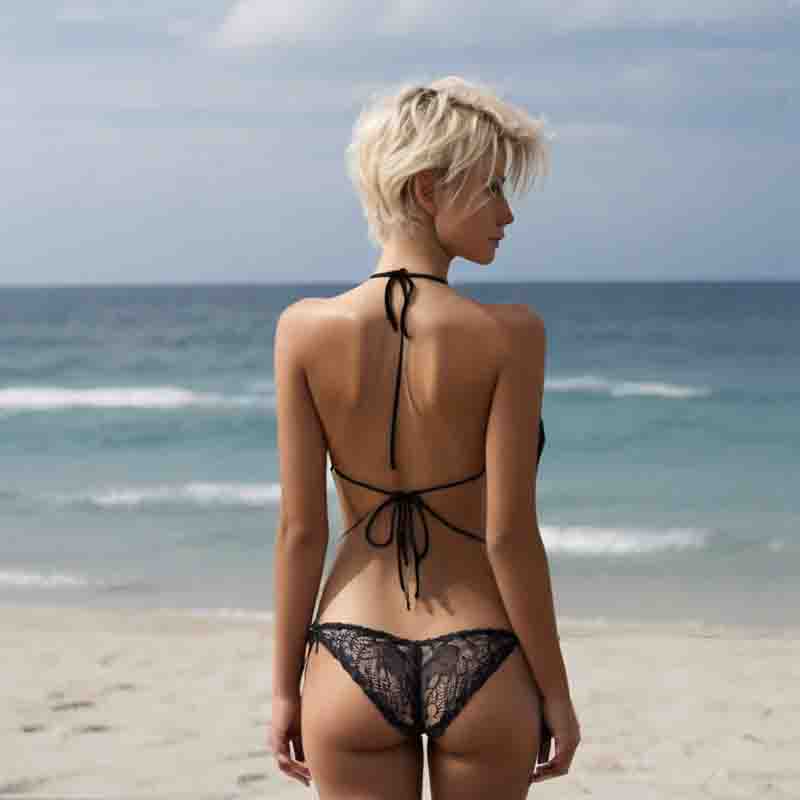Beach Babe Essentials: Your Ultimate Bikini Guide
The bikini, a masterpiece of fashion, has conquered the world's shores and inspired minds since its introduction on 5 July 1946. With its daring design and groundbreaking cut, the bikini has become a cultural icon that epitomises the essence of liberation and self-confidence.

Bikinis are more than just swimwear; they are symbols of freedom, style, and confidence.
The invention of the bikini by Louis Réard was a key event that would profoundly change 20th century swimwear.
The Molitor municipal public swimming pool in Paris hosted a competition for best bathing costume as part of its inaugural summer festival following World War II, attracting a host of unique swimwear designers.
Louis Réard pioneered a two-piece with an exposed belly button, a revolutionary design in terms of both fashion and public morality.
Since media coverage at the time focussed on the atomic bomb tests on the Bikini Atoll, he dubbed the piece "Bikini", thus associating the short two-parter with the explosive power of an atomic bomb.
Initially, Réard was unable to find a model willing to flaunt his creation.
The provocative design led to many models fearing that their reputation would be damaged.
Eventually, nightclub dancer Micheline Bernardini made history as the first woman to wear a bikini.
The introduction of the bikini caused a massive scandal due to its revealing design.
In the 1950s, newspapers and magazines considered it "unthinkable that a girl with tact and decency would ever wear such a thing."
It would take another 20 years before the bikini was established among the general public.
The two-piece bikini epitomises the fusion of style and functionality, offering swimmers and beachgoers alike a versatile and comfortable option for activities in the water.
11 Most Important Facts to Know About the Bikini
-
Origin: The bikini was invented by French engineer Louis Réard in 1946, who named it after the Bikini Atoll in the Pacific Ocean, where atomic bomb tests were conducted around the same time.
-
Debut: The bikini made its public debut on July 5, 1946, at the Piscine Molitor swimming pool in Paris. It caused quite a stir due to its daring design and was initially met with skepticism.
-
Design: The bikini is typically composed of two separate pieces: a top covering the breasts and a bottom covering the groin and buttocks. Its minimalistic design was revolutionary compared to the more modest swimwear styles of the time.
-
Cultural Impact: The bikini quickly became a symbol of liberation and female empowerment, challenging societal norms regarding modesty and femininity.
-
Evolution: Over the years, the bikini has undergone various transformations, with designers introducing new styles, cuts, and materials to cater to changing fashion trends and consumer preferences.
-
Popularity: Despite initial controversy, the bikini gained popularity throughout the 20th century and is now one of the most widely worn swimwear styles worldwide.
-
Variety: There are several different styles of bikinis, including triangle tops, bandeau tops, halter tops, high-waisted bottoms, Brazilian bottoms, and more. This variety allows individuals to choose a style that suits their body type and personal taste.
-
Fashion Trends: Bikini fashion is influenced by seasonal trends, with designers incorporating elements such as prints, colors, and embellishments to create fashionable swimwear collections each year.
-
Sports and Fitness: Bikinis are not only worn for leisure but also for athletic purposes. They are commonly worn by athletes in sports such as beach volleyball, surfing, and swimming competitions.
-
Body Positivity: The bikini has played a role in promoting body positivity and acceptance, encouraging people of all shapes, sizes, and ages to feel confident and comfortable in their own skin.
-
Iconic Moments: The bikini has been featured prominently in popular culture, from iconic movie scenes such as Ursula Andress emerging from the sea in "Dr. No" to famous bikini models like Brigitte Bardot and Marilyn Monroe.
The Bikini has become a symbol of leisure, confidence, and self-expression, with variations to suit various body types and personal preferences.
Bikini Timeline
The history of the bikini is a tale of evolution, controversy, and liberation.
While the modern bikini we know today may seem like a recent invention, its roots can be traced back thousands of years.
| Year | Milestone |
|---|---|
| 1946 | French engineer Louis Réard designs the modern bikini, debuting it in Paris on July 5th. |
| 1950s | Hollywood stars like Marilyn Monroe and Brigitte Bardot popularize the bikini in films. |
| 1960s | The bikini becomes a symbol of women's liberation and sexual revolution. |
| 1970s | High-cut and string bikini styles gain popularity, influenced by beach culture and fashion. |
| 1980s | Fitness trends lead to the rise of high-cut and neon-colored bikini designs. |
| 1990s | Baywatch features lifeguards in iconic red swimsuits, including high-cut one-pieces and bikinis. |
| 2000s | Swimwear brands offer diverse bikini styles catering to various body types and preferences. |
| 2010s | Social media influencers and celebrities drive trends in bikini fashion and body positivity. |
| Present | Bikinis continue to evolve with new materials, designs, and inclusivity in fashion industry. |
This timeline provides a chronological overview of key events and developments in the history of the bikini, from its ancient origins to its modern-day status as a staple of swimwear fashion.
Make Waves: Discover the Hottest Bikini Look

Throughout its storied history, the bikini has undergone a myriad of transformations, reflecting shifts in societal norms, fashion trends, and technological advancements.
Understanding Bikini Styles
Bikinis come in a wide array of styles, each offering its unique look and functionality.
Classic bikini styles such as triangle, bandeau, and halter-neck bikinis are timeless favorites that offer versatility and appeal.
Triangle bikinis feature triangular-shaped cups and adjustable ties, providing customizable coverage and support.
Bandeau bikinis feature a strapless design with a bandeau-style top, perfect for minimizing tan lines and achieving a sleek silhouette.
Halter-neck bikinis feature a halter-style top with straps that tie around the neck, offering added support and lift.
The choice of material plays a crucial role in the comfort, durability, and performance of bikinis.
Riding the Waves of Bikini Trends

Despite initial backlash, the bikini quickly gained popularity, becoming a symbol of women's liberation and sexual freedom in the 1960s.
Bikini trends are constantly evolving, influenced by fashion, culture, and lifestyle.
Current trends in bikini designs, colors, and prints include nature-inspired prints, bohemian vibes, sustainable swimwear, vintage glamour, and athleisure influences.
Nature-inspired prints such as botanical and tropical motifs evoke a sense of escapism and adventure, perfect for beach vacations.
Bohemian vibes, characterized by tie-dye patterns and crochet details, offer a free-spirited and relaxed aesthetic.
Sustainable swimwear, made from recycled materials, reflects a growing commitment to eco-conscious fashion.
Vintage glamour embraces retro-inspired silhouettes and pin-up styles, adding a touch of old-world charm to modern swimwear.
Athleisure influences bring sporty-chic designs and high-performance fabrics to the forefront, catering to active lifestyles.
Functionality Meets Fashion: Practical Considerations

Features to look for in bikinis for swimming and beach activities include secure closures, adjustable straps, quick-drying fabrics, moisture-wicking properties, UV protection, and sun-resistant materials.
While style is important, functionality is equally crucial when it comes to bikinis.
Features to look for in bikinis for swimming and beach activities include secure closures, adjustable straps, quick-drying fabrics, moisture-wicking properties, UV protection, and sun-resistant materials.
Secure closures and adjustable straps ensure a snug and supportive fit, while quick-drying fabrics and moisture-wicking properties keep the skin dry and comfortable.
UV protection and sun-resistant materials shield the skin from harmful sun rays, making them ideal for outdoor activities.
Expert Advice and Recommendations
Swimwear manufacturers, fashion historians, stylists, and influencers offer valuable insights and recommendations for navigating the world of bikinis.
Swimwear manufacturers emphasize quality craftsmanship, attention to detail, and trends in sustainable swimwear production.
Fashion historians trace the evolution of bikini styles, cultural influences, and societal attitudes towards swimwear fashion.
Stylists and influencers provide tips on accessorizing, styling, and achieving a confident and fashionable beach look.
Beach Chic: Get Your Bikini Game On

The bikini embodies the spirit of summer, the lightness of being and the lust for life.
Understanding the qualities of different bikini fabrics is essential for making informed purchasing decisions.
Here's a breakdown of some common bikini fabrics and their key characteristics:
-
Nylon: Nylon is one of the most popular fabrics used in bikini production due to its durability, lightweight feel, and quick-drying properties. It offers excellent stretch and recovery, allowing for a comfortable and flattering fit. Nylon bikinis are also known for their resistance to wrinkles and creases, making them ideal for travel. Additionally, nylon fabrics are often treated with UV protection to shield the skin from harmful sun rays.
-
Polyester: Polyester is another commonly used fabric in bikini manufacturing, prized for its strength, resilience, and colorfastness. Polyester bikinis are known for their ability to retain their shape and color even after repeated exposure to sun, saltwater, and chlorine. They offer good stretch and recovery, providing a snug and supportive fit. Polyester fabrics are also quick-drying, making them ideal for active beachgoers and water sports enthusiasts.
-
Spandex (Lycra/Elastane): Spandex is a synthetic fiber known for its exceptional elasticity and stretchability. It is often blended with other fabrics like nylon or polyester to add stretch and flexibility to bikini designs. Spandex bikinis offer excellent freedom of movement and shape retention, ensuring a comfortable and flattering fit. They are also resistant to wrinkles and creases, making them ideal for packing and traveling.
-
Polyamide: Polyamide, also known as nylon, is a synthetic fiber prized for its softness, durability, and moisture-wicking properties. Polyamide bikinis offer excellent breathability and moisture management, keeping the skin cool and dry even in hot and humid conditions. They are also resistant to pilling and abrasion, ensuring long-lasting wear. Polyamide fabrics are often used in seamless bikini designs for a smooth and streamlined look.
-
Microfiber: Microfiber is a lightweight synthetic fabric known for its softness, smoothness, and moisture-wicking properties. Microfiber bikinis offer exceptional comfort and breathability, making them ideal for all-day wear. They are also quick-drying and resistant to fading, shrinking, and wrinkling, maintaining their shape and color over time. Microfiber fabrics are often used in high-performance bikinis designed for active lifestyles.
-
Recycled Fabrics: With increasing awareness of environmental issues, many bikini brands are turning to recycled fabrics made from post-consumer waste like plastic bottles or fishing nets. Recycled fabric bikinis offer the same qualities as traditional fabrics, including durability, stretch, and quick-drying properties, while reducing environmental impact. They are an eco-friendly choice for conscious consumers looking to minimize their carbon footprint.
-
Cotton: While less common in bikini production, cotton is a natural fiber valued for its softness, breathability, and moisture-absorbing properties. Cotton bikinis offer a comfortable and breathable option for casual beach days or lounging by the pool. However, cotton fabrics may not offer the same level of stretch and support as synthetic fabrics, and they may take longer to dry after getting wet.
Whether seeking durability for frequent use, performance for active pursuits, or sustainability for environmental consciousness, there's a bikini fabric to suit every lifestyle and taste.
Bikini Babes Unite: The Swimwear Revolution

From the bold designs of the 1950s to the daring patterns and innovative materials of the modern era, the bikini has continually reinvented itself as a celebration of the many facets of feminine beauty.
Bikinis are not just swimwear; they're a statement of style and confidence.
With so many styles, brands, and trends to choose from, there's a bikini out there for everyone.
Whether you prefer classic designs or trendy prints, investing in a quality bikini that fits well and makes you feel fabulous is key to enjoying your beach or poolside adventures to the fullest.
Understanding different styles, materials, trends, and functionality is essential for making informed decisions and staying ahead of the curve in swimwear fashion.
Bikini: FAQ
Are you curious about music, art, technology, fashion, lifestyle, and beer?
If so, then you need to subscribe to the free Likewolf newsletter.
100% privacy. When you sign up, we'll keep you posted.
Mysterious and Seductive
A Bold And Unforgettable Look
